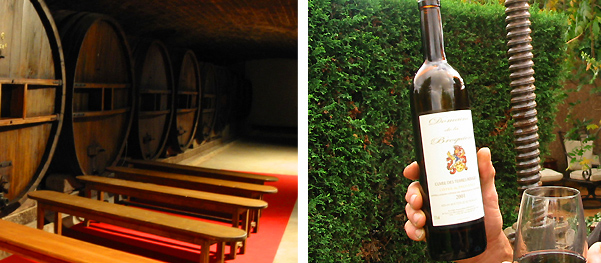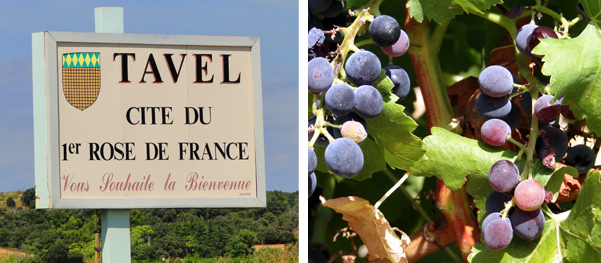The wines and vineyards of the Gard Provençal
The Gard Provençal's winters are warm and dry, its spring months warm and wet, whilst very hot and dry summers precede warm rainy autumns. In addition the very strong Mistral wind keeps the vineyards healthy by blowing away any risks of disease, thereby providing particularly suitable conditions for the production of quality wines.
The wines produced on the baked land of the Gard Provençal have the denomination Côtes-du-Rhône.
The crus (Tavel and Lirac), the Côtes du Rhône Village and the vins de pays will all delight your palate and further contribute to a refined and convivial stay.
THE CRUS OF THE GARD PROVENÇAL
- TAVEL wines from the Gard Provençal
Tavel's rosé is without doubt the best ambassador for wines produced in the Gard Provençal.
Vines have been grown and tendered in the Tavel area since Gallo-Roman times.
It rapidly became evident that nature had gifted the village with a truly exceptional terroir. Lauses (limestone rocks), flat stones, sand and cailloutis all contribute to compensate for a modest yield, by producing a wine which offers a strong concentration of aromas, harmonious fragrances and a truly unique structure, which has earned Tavel's rosés the motto 'King of Rosés, Rosé of Kings'.
As beloved by kings as it was by the Avignon popes, Tavel wines have built up a solid following which has endured over the centuries. As far back as the 16th century, vineyards replaced any other type of product growing.
Tavel is the only AOC which exclusively rosé, and is composed of ten cépages (amongst which are the varieties grenache, cinsault, syrah, mourvèdre, clairette…).
Tavel rosé is appreciated and popular throughout the world. Its gustative qualities make it as appreciated during the winter months as it is in summer, and it can accompany all types of dishes.
Nowadays, 960 hectares, encompassing 34 private cellars and one wine cooperative, are dedicated to the AOC production.
- LIRAC wines from the Gard Provençal
A neighbouring village of Tavel, the commune of Lirac also expanded rapidly during the Avignon papal era (it has been estimated that each person in the Papal court was drinking, on average, 2.5 litres per day…).
Lirac's inhabitants have succeeded in getting the very best out of what is a difficult soil to cultivate, and 715 hectares are planted with vines. Whilst the yield is relatively low (42hl/ha) the quality of the vines produced here is truly exceptional.
Although still predominately a producer of red wines, Lirac is the first cru of the Côtes-du-Rhône which has extended its production to all three colours, red, white and rosé.
Grown on a variety of soils, dependent on the colour, Lirac wines are composed from an alliance of numerous grape varieties such as black grenache, syrah, cinsault and mourvèdre for reds or rosés, white grenache, clairette, bourboulenc and others for white wines.
The wine growers here describe their production as elegant, powerful and refined.
The reds are ideally suited to small game and chicken dishes, whilst the rosés prove perfect with spicier dishes and the whites complement fish and dry cheeses. |
COTES-DU-RHONE VILLAGES APPELLATIONS – NAMED VILLAGES (AOC)
- CHUSCLAN and LAUDUN:
Produced on sun-drenched terroirs with very little water, the wines of Chusclan and Laudun are vins de semi-garde, ideal to be enjoyed outdoors, preferably before their fifth year.
550 ha of vines produce over 20,000 hl per year.
Composed of subtle blends of different grape varieties (grenache, syrah and mourvèdre for the reds, grenache and clairette for the whites), they offer a powerful combination of strength and generosity.
The quality of the wines of Chusclan first came to the fore thanks to a rabbit-based recipe much loved by King Louis the sixteenth.
In recent years, the 2005 and 2009 vintages were judged truly exceptional…
- SAINT-GERVAIS
Whilst they used to be implanted in the Cèze valley, nowadays the local winemakers prefer the dry coteaux and the stony soil of the plateaux.
Vines cover an area of over 140 ha for a production close to 5,000 hl.
There is a wide array of wines – reds, whites and rosés – to complement every type of dish. The vintages of 2005 and 2009, the finest in recent times, are much sought after.
- SIGNARGUES
It is in the heart of the territory of Signargues that a double-faced statuette of Bacchus was unearthed. The statuette, which is now kept in the Louvre museum in Paris, symbolizes the age-old links that this area enjoys with its vineyards.
Cultivated over four communes of the Gard (Rochefort, Saze, Domazan and Estézargues), grapes here benefits from a very favourable climate and a terroir made up mainly of galets roulés oxydés.
The soil's specific nature here have enabled wine makers to privilege quality over quantity and to elaborate a vin rouge de garde requiring a few months of maturing in cuves or fûts.
VIN DE PAYS
For over 25 centuries, the region of the Languedoc-Roussillon has produced vins de pays, and has become the first French producer of vins de table.
The Gard Provençal is the terroir of, amongst others, the vins de pays 'Coteaux-du-Pont-Du-Gard', 'Duché-d’Uzès' and 'Vallée de Cèze'.
There are a great number of different wines made by passionate winemakers to be discovered.
Do not hesitate to visit the cooperatives or private cellars to sample the different wines on offer. You will rarely leave empty-handed…
|



